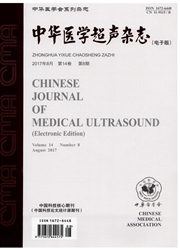

 中文摘要:
中文摘要:
目的 研究中孕期胎儿系统超声检查中的各种切面,探讨这些切面的临床意义.方法 总结和归纳我院2000年7月至2009年7月9年间的胎儿系统超声检查的经验,对比分析国外产科超声检查经验和规范,通过研究各种畸形在不同切面上的表现,对中孕期产科超声检查过程中需要检查的切面进行详细研究,规范胎儿系统超声检查的标准切面.结果 笔者研究了中孕期胎儿系统超声检查的各个切面,发现32~39个胎儿切面在胎儿超声检查中非常重要,绝大部分胎儿结构畸形可通过这些切面筛查并诊断出来,从而提高胎儿畸形产前检出率.结论 胎儿系统超声检查中32~39个切面是中孕期系统超声检查中的重要切面,这些切面的制定和规范,有利于提高胎儿畸形产前检出率,为产前超声诊断规范化培训和质量控制奠定基础.
 英文摘要:
英文摘要:
Objective The various anotomic ultrasound sections of the fetus in the second-trimester of pregnancy were studied to determine the clinical application and significance of these sections. Methods Based on our experience of anotomic ultrasound examination of the fetuses in the past nine years, the foreign standards and experience of prenatal ultrasonopraghic examination in obstetrics were analyzed and compared. The sonographic features in different sections of various fetal malformations were studied and the necessary ultrasound sections of each fetus in the prenatal ultrasound examination were analysed. The specification of these sections in healthy fetus was provided to minimize the misdiagnosis. Results The various ultrasound sections of the fetus were analysed and 32 to 39 specific ultrasound sections of the fetus were necessarily obtained in fetal anatomic survey. Most of the fetal malformations can be recognized and diagnosed by scanning these sections and the detection rate of fetal abnormalities would be increased. Conclusion By obtaining the specific 32-39 ultrasound sections of each fetus at'e very important in fetal anatomic ultrasound examination in during the second-trimester of pregnancy. Stand~lJ'dization of these sections is beneficial to increase the detec- tion rate of fetal abnormalities and to standardize training programme in prenatal diagnosis and quality control.
 同期刊论文项目
同期刊论文项目
 同项目期刊论文
同项目期刊论文
 期刊信息
期刊信息
